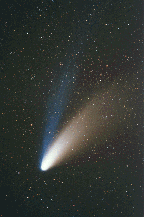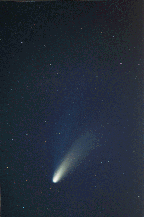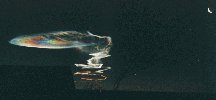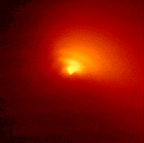
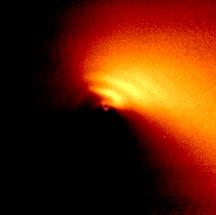
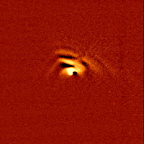
|
This image of Comet Hale-Bopp was obtained with the Hall 42-inch (1.1-m)
telescope at Lowell Observatory on 1997 Mar 6 by Sue Lederer (U. Florida) and
David Schleicher (Lowell Obs.), and processed by Tony Farnham (Lowell Obs.).
A red, narrowband filter was used to isolate light reflected by dust grains
in the comet's coma. Pseudo-colors have been applied, where dark red
represents low intensity, then bright red, and finally yellow/white the
highest intensity. The first figure is "raw" (only bias subtracted and
flat-fielded) and shows the comet centered, with a very bright core, and
with the dust dropping off in brightness with distance from the center.
The second figure shows the same image after processing to remove the gross
fall-off in brightness, allowing detailed dust structures to become visible.
[A 1/rho canonical dust fall-off was ratioed out, where 1/rho would be
expected for a simple, static comet for which dust is flowing radially
outward uniformly in all directions.] The extreme asymmetries in the coma
are clearly evident in both views, with the upper-right quadrant being the
brightest with the most material and the lower-right being the faintest.
The 2nd figure better shows brightness variations within the stuctures of
the upper-right quadrant, revealing a series of dust arcs, due to short-term
changes in production modulated by the rotating nucleus (i.e., active regions
on the surface turn "on" and "off" as they rotate into and out of the
sunlight). The 3rd figure shows the image processed using an unsharped mask
technique, which emphasizes strong changes in brightness. This method
makes the full extent of each arc more apparent.
Other notes:
The heliocentric distance of the comet was 1.02 AU.
The geocentric distance was 1.41 AU.
Solar phase angle is 46 deg (the sun is between us and H-B).
The position angle of the sun is 159 deg (North is at the bottom and East is to the left, so the sun is towards the upper-left).
The image size (side-to-side) is 3.8 arcminutes or about 230,000 km.
|
